On those occasions when I see injured birds surviving and even thriving it makes my day.
Recently my good friend Billy Fenimore, Director of the Farmington Wildlife Center, told me about a Red-tailed Hawk with an injured leg that has been successfully hunting for voles near the Wildlife Center. He said the hawk uses only one leg and foot to capture the voles and it had been doing so for some time.
Two days ago I photographed what is apparently the same immature hawk hunting from a kestrel box on the refuge. Documenting ‘her’ active lifestyle despite her injury was a ‘feel good’ experience for me and I accomplished a difficult photographic feat with her to boot.
Photographing landing birds is hard, much more difficult than photographing them taking off. In the past I’ve considered myself lucky to get a single sharp and unclipped photo of a bird, any bird, during its landing approach. But with this hawk I managed to get five sequential photos of her as she approached the nest box and touched down. Not all of them are great shots but they do show the flight dynamics of landing, as modified to compensate for her injury, and I consider it an accomplishment to get that many sequential approach shots.
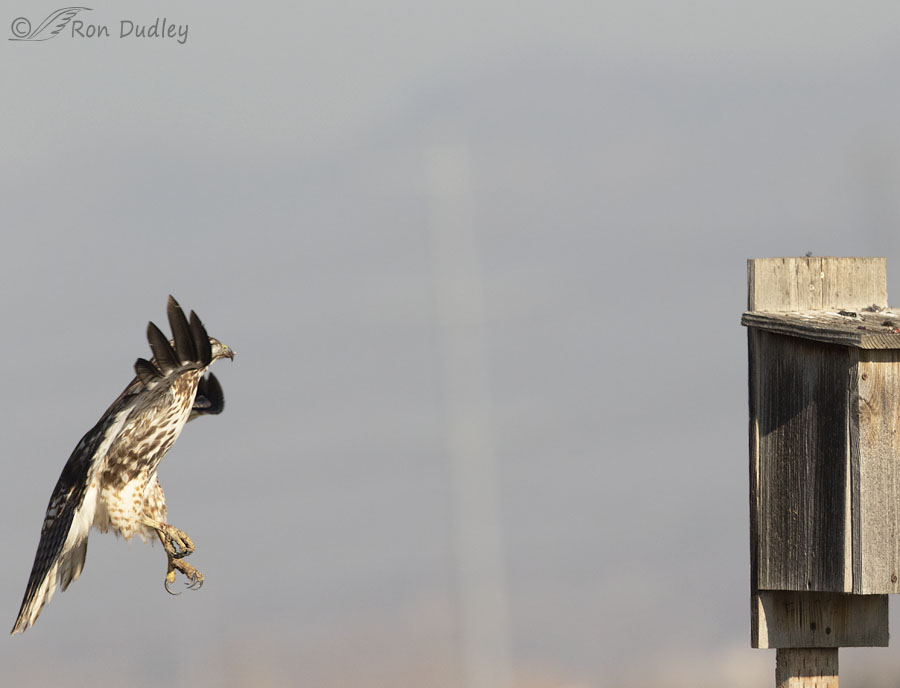
Here she’s returning to her nest box hunting platform after an unsuccessful attempt to snag a vole she’d spotted nearby. The injured leg is her left one. I looked carefully at other photos of her and see no obvious injury on her foot or tarsi (lower leg) so perhaps the actual injury is on her upper leg.
That aggravating vertical and out of focus white line between the hawk and the nest box is a utility pole in the far background. I try to not let it bother me because this series is more about behavior and flight dynamics than it is about aesthetics.
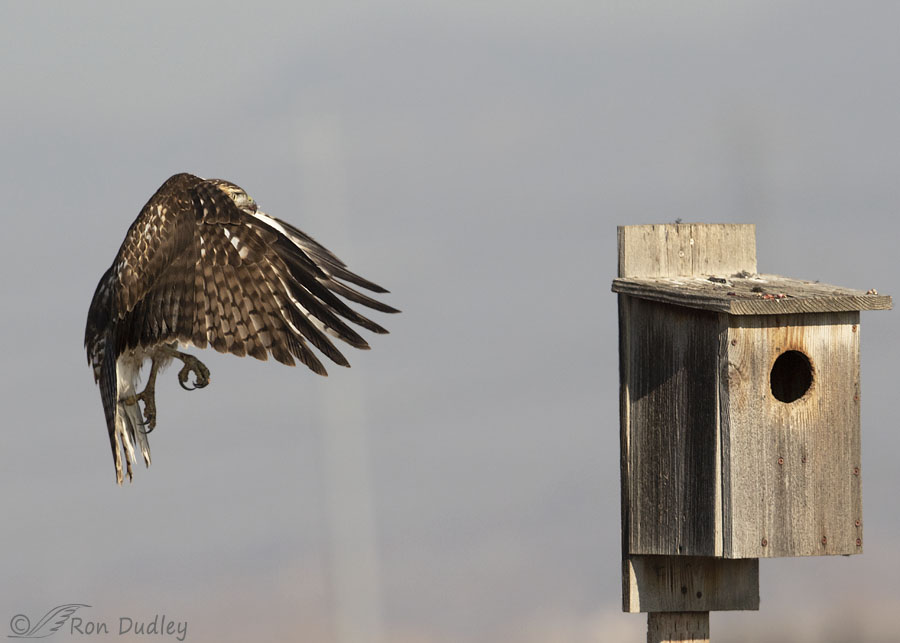
She doesn’t land or stand on the injured left leg. Here we already see a disparity between how she uses and doesn’t use her legs just prior to landing – she’s in the process of bringing her right foot forward to land on it exclusively while she keeps the injured leg back and mostly out of the way.
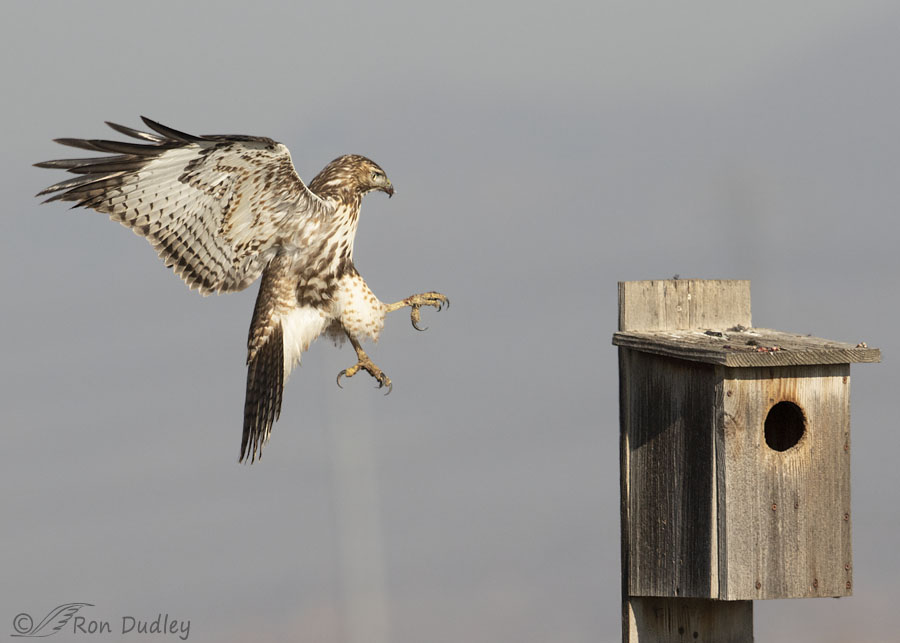
This is my favorite shot of the landing process. I like her flight posture relative to her soon-to-be perch and it documents clearly the unusual asymmetrical position of her feet and legs as she tries to protect her injured left leg just prior to landing.
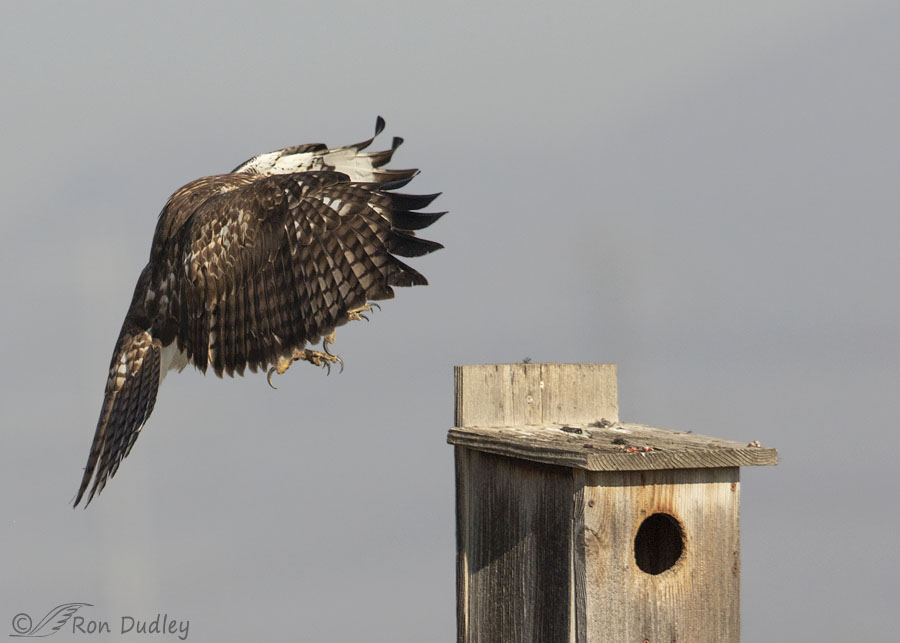
You won’t often see me post photos where we can’t even see the head of the bird but this one clearly shows her efforts to use her ‘air brakes’ to slow her speed and soften the landing and the unusual asymmetrical position of her feet.
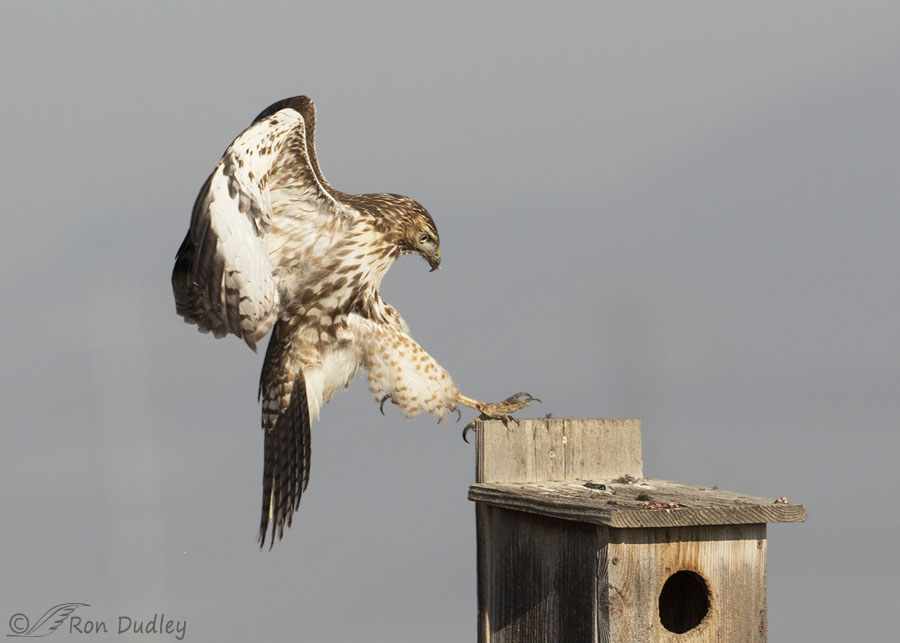
She sticks the landing but only with one foot. The injured leg is behind the ‘pantaloons’ of her right leg, revealing only some of the talons on that foot.
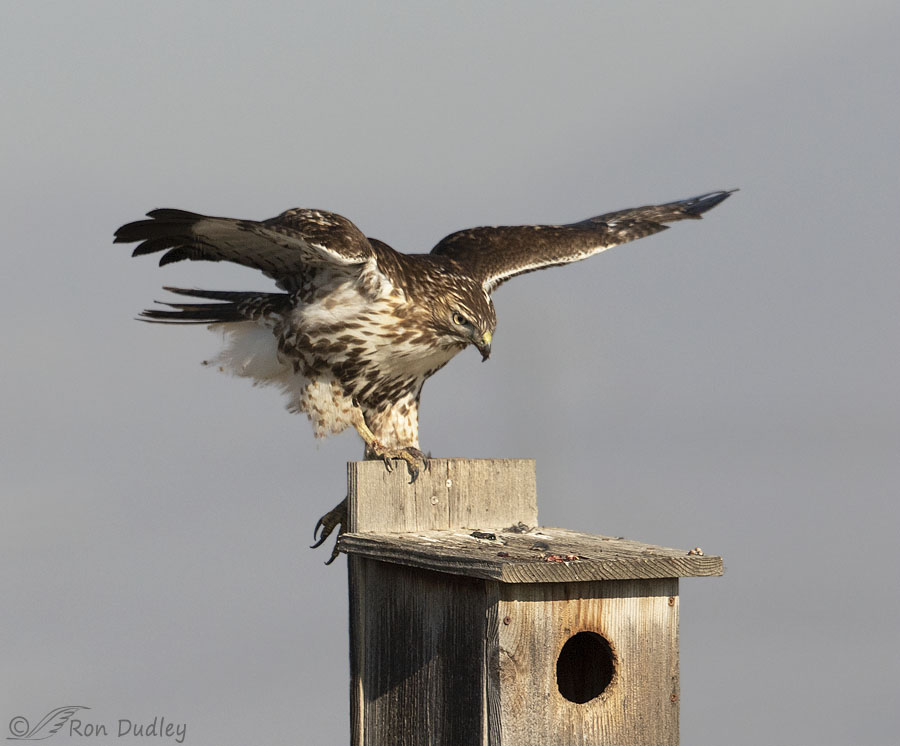
She lands very gingerly to protect the injured leg and uses her wings extensively to stabilize herself before folding them into a resting position. Here we see the foot on her injured left leg being held protectively out of he way behind the nest box. While she’s perched she stands only, or at least mostly, on her right leg.
While I was with her I saw her unsuccessfully go after prey several times but I’m convinced she isn’t going hungry. In some of my photos I could see that her crop was far from empty and there’s fresh vole guts on top of the nest box, some of them still bloody and fresh. This nest box is one of her habitual hunting perches. And Billy says she’s a skilled and successful hunter even with her injury so I’m not particularly concerned about her.
Although I certainly wish she didn’t have the injury. Unless her leg heals quickly, and it might, she’ll be at a distinct disadvantage this winter. But I still have what I think are reasonable hopes for her long term survival, even though it could easily go either way.
Ron
Image techs for this series: 1/2500 – 1/3200, f/7.1, ISO 500, Canon 7D Mark II, Canon EF 500mm f/4L IS II USM


Your images are really impressive, Ron, but my heart aches for this beautiful hawk after reading Louise’s and Liz’s comments about her chances. I will simply hope for your more positive outlook for her since there’s no other good option here. I’m happy to have counted 5 Red-tails perched in various spots overlooking a large vacant field near my house this afternoon — all appearing healthy and happy themselves.
Chris, I’ll be watching for her. And rooting for her.
🤞 😊
So glad she seems to be making it! Thank you for these heart-wrenching, yet hopeful photographs.
And thank you for your daily dose of beauty, education, and wonderment. ❤️
And Happy Hanukkah to my fellow Red Sea Pedestrians.
Same to you, Marty. Thanks.
Hoping she can heal. Living in the wild can be tough. I too like the 3rd picture.
It sure can be and very often is. Thanks, Jean.
Really an incredible series showing just how tough it can be and how adaptive and strong birds are. I was also struck by the angle and profile of the landing spot as that plywood edge just looks like a tough grab to me.
Ron, congratulations on yet another outstanding and illuminating series.
Super shots of this exceptional and beautiful raptor.
Thanks very much, Dave.
I’ve been a volunteer raptor rehabber and falconer for many years and I have seen birds that have recovered from serious injuries – even fractures – on their own in the wild. But she’s a young bird and would have a much better chance with medical care. Is there someone you know – a falconer or rehabber – who could trap her and assess the situation? The downside is that if this is an old injury that has begun to heal improperly, treatment might not be possible and she would likely be euthanized. As an earlier poster said, a hawk that can’t put full weight on both feet will eventually develop sores on the good foot that will destroy the bone and lead to a painful death. As it is, I hope she can recover. But hoping doesn’t make it true.
Liz, please see my response to Louise Shimmel, below.
I do hate to be a Debbie Downer but one of the things I see, as a raptor rehabilitator for the last 30 years, is that the inability to bear weight on one leg – especially for a big bird like a red-tail – leads almost inevitably to pododermatitis or bumblefoot (a generic term for a foot infection) on the good foot. And ultimately a systemic infection. If someone could trap the bird and take it to DaLyn, she could x-ray and determine if the left leg is fixable. If there’s a fracture, the sooner the better or it will heal but badly. Of course, that also runs the risk of the decision to euthanize if it’s not fixable – but in my opinion, that’s more humane than letting her starve. I do admire hos she is surviving a difficult situation, but my experience is that it probably won’t last.
I am so sorry to read this – and sadly unsurprised.
Louise, I wondered about that but I know of no one who can/will trap her. As far as I know the best outcome we can hope for is that her leg isn’t broken and she heals quickly.
I have said it many times, life is not easy. Humans have it good.
Easy is relative isn’t it.
Awe and wonder.
I do hope that she doesn’t need those adaptations on a permanent basis but LOVE that she has been able to make them (and quickly too) in the short term.
A big, big hooray for survivors and thrivers.
Thanks, EC. I think she has a reasonably good chance.
Sensational series Ron! Thanks for sharing.
Charlotte Norton
Thanks, Charlotte.
Incredibly adaptive! I loved seeing the use of air brakes! She d oes seem to be hanging in there with a fat crop. I’ll keep my fingers crossed for her. And for you to document her more. 😀
“I loved seeing the use of air brakes”
Arwen, I don’t get a lot of photos of those air brakes in action because they’re used most often during landings and landings are so difficult to photograph.
At once heartbreaking and inspiring. Just terrific photos and narrative. But then I’ve come to expect that from you.
Thanks very much, Lyle.
Thanks for this expo of a gallant animal……we humans have been so pre-
occupied with our current health challenges—minor, when you compare them
to those of creatures struggling to survive winter and
injuries out in the wild — your photos present an immediate reminder of just
how tough life can be for them, and how often they manage to survive conditions that we humans probably wouldn’t….
Thank you, Kris. Yup, most humans in a similar situation probably wouldn’t last long.
What an outstanding series Ron. She is a true Marine – adapt and improvise – and she is doing it. Those last two shots landing on the Kestrel box are awesome. Great job. I get reports from Liberty Wildlife in Phoenix where they take in thousands of birds and animals every year to be treated and rehabilitated. Just think of the thousands who like your Red-tail here are out there continuing to try to survive with injuries.
Everett, for over a week now we’ve had two young pelicans near one of our ponds that obviously weren’t doing well. One of them is now dead and has been scavenged (the other one has apparently left the area). Every time I visit the pond that carcass is a stark reminder of how difficult it is ‘out there’ for birds.
Interesting series and great the hawk has been able to adapt to her current injury. Seems to be able to flex the left foot some so that’s a plus. Winter IS particularly unkind to any with a handicap. 😞 Hope she recovers and, perhaps, you can find her again at a later date……😀
Judy, she seems to be hanging around so perhaps she’ll winter in the area. After several years of depressed vole populations they seem to have made a comeback so I think there’s a good chance she’ll stick around.
Sorry for the hawk, but your sequence of photos and description are detailed and informative.
Thank you, Kenneth.
Wonderful photos I hope the hawk’s leg recovers. Winter is not kind to birds with one leg that cannot be used for perching. I hope she is at least able to tuck it into her feathers when she is sleeping. She is definitely a capable hunter and skilled at landing. And it looks like she has some use of the left foot so that is definitely promising.
Melanie, based on other photos she seems to be able to pull her left foot into her belly plumage so I have what I think are reasonable hopes for her this winter.
But she’ll unquestionably be at a disadvantage unless her injured leg heals fairly quickly.